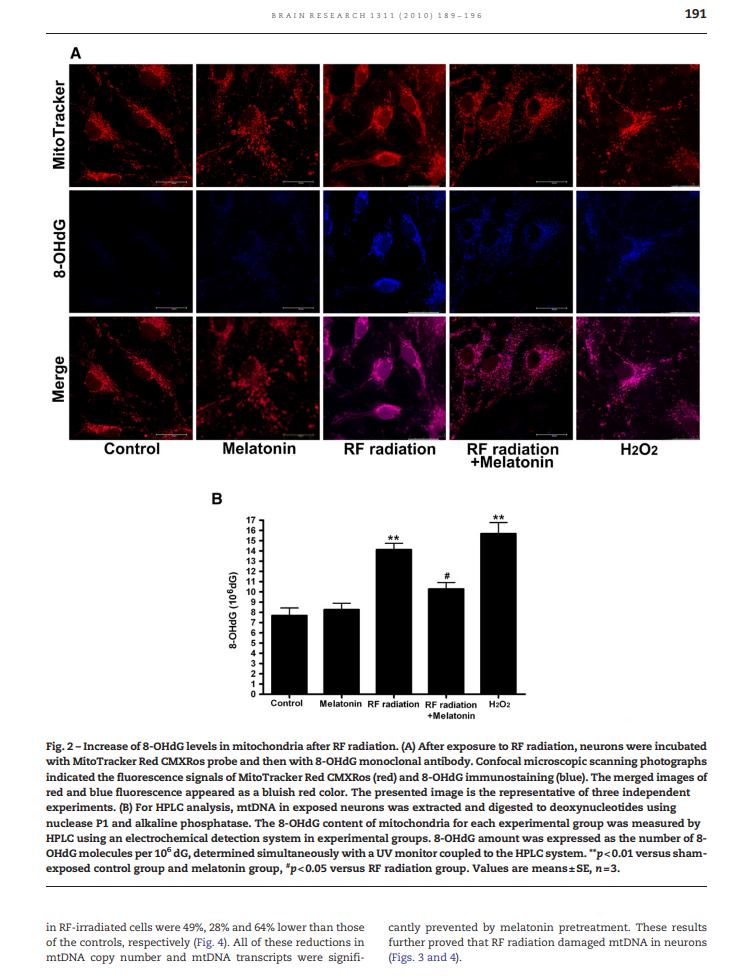
-- Exposure to 1800 MHz radiofrequency radiation induces oxidative damage to mitochondrial DNA in primary cultured neurons --

ABSTRACT:
Increasing evidence indicates that oxidative stress may be involved in the adverse effects of radiofrequency (RF) radiation on the brain. Because mitochondrial DNA (mtDNA) defects are closely associated with various nervous system diseases andmtDNA is particularly susceptible to oxidative stress, the purpose of this study was to determine whether radiofrequency radiation can cause oxidative damage to mtDNA. In this study, we exposed primary cultured cortical neurons to pulsed RF electromagnetic fields at a frequency of 1800 MHz modulated by 217 Hz at an average special absorption rate (SAR) of 2 W/kg. At 24 h after exposure, we found that RF radiation induced a significant increase in the levels of 8-hydroxyguanine (8-OHdG), a common biomarker of DNA oxidative damage, in the mitochondria of neurons. Concomitant with this finding, the copy number of mtDNA and the levels of mitochondrial RNA (mtRNA) transcripts showed an obvious reduction after RF exposure. Each of these mtDNA disturbances could be reversed by pretreatment with melatonin, which is known to be an efficient antioxidant in the brain. Together, these results suggested that 1800 MHz RF radiation could cause oxidative damage to mtDNA in primary cultured neurons. Oxidative damage to mtDNA may account for the neurotoxicity of RF radiation in the brain.
1. Introduction
The world-wide and rapidly growing use of mobile phones (MP) has raised considerable concerns about their potentially hazardous effects on human health. Compared to the other organs, the brain is exposed to relatively high specific absorption rates (SAR) due to the close proximity of the mobile telephone device to the head. Exposure to radiofrequency (RF) radiation emitting from MP has been postulated to result in a variety of neurological effects, including headaches, changes in sleep patterns, modifications in neuronal electrical activity, increases in the permeability of the blood–brain barrier (BBB) and disturbances in neurotransmitter release (Hossmann and Hermann, 2003; Repacholi, 1998; Valentini et al., 2007). There is growing evidence to suggest that RF radiation induces oxidative stress in the brain and in other tissues (Ilhan et al., 2004; Irmak et al., 2002; Koylu et al., 2006; Moustafa et al., 2001; Oktem et al., 2005; Ozguner et al., 2005a,b; Sokolovic et al., 2008; Yurekli et al., 2006). Oxidative stress is known to be essential for pathophysiological processes in the brain, and it plays critical roles in cell apoptosis, general and specific gene expression, DNA damage, cell proliferation, inflammation process and mitochondrial dysfunction (Hayashi et al., 2008; Lin and Beal, 2006). The involvement of oxidative stress in manifold processes is compatible with the diverse nature of the observed effects induced by RF radiation (Balik et al., 2005; Cleary et al., 1996; Diem et al., 2005; Koylu et al., 2006; Schwarz et al., 2008; Zhao et al., 2007a,b). Thus, oxidative stress may be involved in the adverse effects of RF radiation on the nervous system.
Mitochondria are the major sites of production of reactive oxygen species (ROS). ROS are toxic by-products of respiration, and excess ROS are known to cause oxidation of unsaturated fatty acid, proteins, and DNA. Mitochondrial DNA (mtDNA) is particularly susceptible to oxidative stress for a variety of reasons, including its lack of protective histone-like proteins, its insubstantial capacity for repair following damage, and its proximity to the respiratory chain in the mitochondrial inner membrane (Evans et al., 2004). MtDNA damage is reflected by the presence of mtDNA mutation, by a decline in mtDNA copy number, and by a reduced number of mitochondrial RNA (mtRNA) transcripts (Ide et al., 2001). Each of these types of mtDNA damage can amplify oxidative stress by encoding the deficient critical proteins for the respiratory chain, which exacerbates further production of ROS and aggravates the oxidative damage to mitochondrial function (Evans et al., 2004; Wallace, 1999). Indeed, oxidative damage to mtDNA contributes to mitochondrial dysfunction in various mitochondrial-related diseases including aging, neurodegenerative diseases and ischemia. The presence of mtDNA mutations is closely related to a variety of neurological symptoms, such as migraine, dementia, and ataxia (Lin and Beal, 2006; Taylor and Turnbull, 2005; Xu et al., 2009). Therefore, there is the possibility that RF radiation could cause oxidative damage to mtDNA in nerve cells, and this may account for the adverse effects of RF radiation on the nervous system. In order to address this, we exposed primary cultured cortical neurons to 1800 MHz radiofrequency radiation at the SAR value of 2 W/kg. We observed a striking degree of oxidative damage to mtDNA in these neurons. In addition, we discovered that these oxidative injuries to mtDNA could be successfully prevented by melatonin, a pineal neurohormone with known antioxidant capacity especially in the brain (Lee et al., 2001; Sokolovic et al., 2008).
View and Download the entire PDF Medical Journal here ----> 